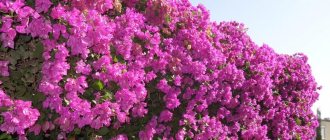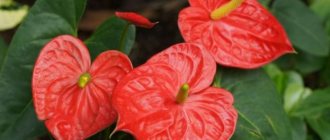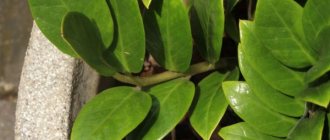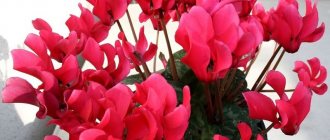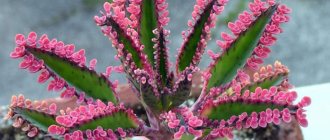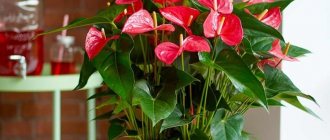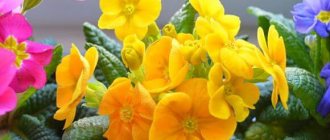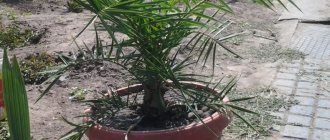Anthurium is a tropical plant with a flower in the form of an elongated cob with a bright glossy cover. It can have different shapes and different colors.
Dear readers! For you, we have created communities on social networks in which useful articles and interesting ideas are published several times a day! Subscribe and receive useful content in a convenient format! Different types of anthuriums can be either epiphytes (growing on tree bark) or semi-epiphytes (growing next to trees in fallen bark, leaves and branches covering the soil).
There are up to several hundred species of anthurium around the world, but only three species are popular among gardeners: Anthurium Andre, Anthurium Crystal and Anthurium Scherzer.
Anthurium is popularly called “Male Happiness”. According to one version, it is named so because the plant in appearance resembles a hot, flaming heart-veil, pierced by an arrow-cob.
How often to water the “Male Happiness” flower?
Due to its tropical origin, anthurium does not tolerate drought , but if you overdo it with watering, the roots will simply begin to rot.
In addition, overwatering leads to the spread of mold. When watering a plant, you need to rely on observations of the flower. If the soil feels dry when you feel it, then it’s time to water the flower.
The temperature in the room is also of great importance. If it is high, then you need to water more often. If the air is cooler, then watering should be reduced accordingly.
Also, a lot depends on the age of the anthurium. A young flower requires more moisture than an older specimen. Like many tropical flowers, the frequency of watering depends on the time of year.
Popular care tips
Anthurium is a rather capricious plant. Adapting to the often unstable conditions at home is not always easy for him. It requires a lot of attention and quick response even to small signals of an uncomfortable environment.
When trying to provide the plant with such careful care, you can take into account some features and nuances that will help create favorable conditions and achieve long-term flowering of anthurium:
- The plant prefers acidic soil , so it is recommended to add a little softener to settled or filtered water for irrigation. If the water is very hard, the tips of the leaves will begin to brown.
- Watering in winter should be infrequent and moderate. It is advisable that the soil dry out at least 1/3 before the next moistening. Overmoistening makes anthurium more vulnerable to various diseases and pests.
- During transplantation, it is recommended to add peat and a little sphagnum moss to the substrate.
- The most dangerous enemies of anthurium are direct rays of the sun and drafts, so the plant must be carefully protected from them.
- It is very important to have good drainage in the pot. Thanks to it, excess water will drain into the pan and will not cause rotting of the roots.
- If the selected fertilizer is suitable for anthurium, it is not recommended to change it.
- It is important not to forget that the plant is poisonous and can cause poisoning if ingested.
Watering methods
Most often, gardeners prefer bottom watering, that is, in a tray. This is not the best way for anthurium. Anthurium has aerial roots on the lower part of the stem. They also need to get moisture. Therefore, it is recommended to cover the base of the plant with sphagnum moss.
It retains moisture and thus nourishes these same roots. You can also use mixed irrigation, that is, water the soil directly and add water to the pan.
Important! When watering a plant from above, do not pour water on the leaves, and especially the flowers. This can lead to a deterioration in the appearance of the flower. Droplets of water dry out and leave unsightly marks.
Anthurium is very good at spraying from a spray bottle, while experts advise moistening not the flower itself, but the air around it, especially in winter.
Well, the last way to moisturize is to place a container with a flower on a tray filled with expanded clay and water. Evaporating water moisturizes both the soil and the flower as a whole.
Remember! It is very useful to periodically arrange a “bath day” for anthurium. You can wipe the leaves and flowers with a damp cloth, but be sure to dry all surfaces afterwards. Otherwise, water stains will remain on the flower. Or, the anthurium “bathes” in the shower. This way you can wash off all the dust from it. After this, the procedure for drying the surfaces of the leaves.
Types of propagation of anthurium
Anthurium can be propagated in 3 main ways:
- Division (separation of several stems from the mother plant and further transplantation into a separate pot);
- By cuttings (cutting off the top of the stem and rooting in a separate pot with peat);
- Using aerial roots - they are cut off and placed in a separate peat pot.
Although you can try and grow anthurium from scratch, that is, using seeds. First you need to pollinate the flowers, and when bright fruits and berries appear, you can pick them and extract the contents.
The algorithm is as follows:
- Rinse the seeds under running water;
- Soak them for 2 hours in a solution of potassium permanganate 0.1%;
- Place the seeds on damp foam rubber in a separate shallow container, cover the top with polyethylene or glass;
- When they germinate, they are placed shallowly in the soil several times;
- Once the seedlings have grown to 7 cm, they can be placed in separate small pots of about 0.2 liters.
What is orientation to the seasons?
Winter
As a rule, flowers need to be watered much less often in winter. Anthurium is no exception to this rule. Watering is carried out no more than once a week. The main condition for wintering is to monitor the temperature. The tropical beauty simply cannot withstand temperatures below 10-12 degrees, and sub-zero temperatures are out of the question.
Attention! Draft is the worst enemy of anthurium. Under no circumstances should you keep the flower in actively ventilated rooms.
Summer
Anthurium is a very heat-loving flower, and therefore summer is the most fertile time for it.
You can water it more often - up to 2-3 times a week, and 20-30 minutes after watering you need to pour out the excess water that remains in the pan , otherwise rotting of the roots cannot be avoided.
Gentle, frequent misting of the air will be very helpful.
Spring and Autumn
In spring and autumn, you need to carefully monitor the absence of drafts, good lighting and water the flower as needed. If the anthurium is actively growing or has begun to bloom, a little more water is needed.
Features of anthurium flowering at home
Under favorable conditions, anthurium can delight you with bright colors from the beginning of spring until late autumn. One inflorescence lasts from one to one and a half months. By the way, there are several tricks to stimulate early flowering. To do this, in winter you need to gradually increase the air temperature, say, bring it to 20 degrees in January. And closer to spring, the anthurium can be watered with water at a temperature of 40-60 degrees. This way the plant is activated and wakes up faster.
The shape of the flower usually resembles a heart, sometimes the edges are curved, and in some varieties they are straight. The diameter of the inflorescence can reach 50 cm.
What kind of water is needed for irrigation?
Anthurium is very sensitive to water. More precisely to its temperature. Watering it with cold water is strictly contraindicated. Warm water or water at room temperature is ideal. You cannot water a flower with tap water - this will negatively affect its health and appearance. Hard water is also unacceptable for a flower.
Additional Information! It is best to fill bottles with water and leave them at room temperature. It is best to use this water after 3-4 days.
The soil
You can pick up soil for anthurium at a garden center or store, but it’s better to make it yourself. To do this, you will need leaf humus, humus soil, soil from rotted pine needles, peat, sand (river), charcoal, small pieces of pine bark and crushed sphagnum.
Moreover, two parts are taken of leaf humus and coniferous soil, and one part of sand, peat, humus soil, pine bark and sphagnum.
Although pots and containers are made from various materials, , glazed, and plastic are best suited for flowers
Be sure to add drainage to the bottom of any container . The layer height can be from 3 cm to one quarter of the pot. Medium-sized expanded clay, crushed stone (washed) or small pebbles are perfect for drainage.
Diseases that occur due to improper watering
As mentioned above, anthurium does not like overwatering. As a result, the root system begins to rot, and with it all other parts of the flower. The leaves of anthurium suffer the most, since they make up the main volume of the flower.
Leaves may darken and become covered with dark spots. This happens to them due to too frequent and abundant watering.- When might leaves become covered with white spots? Most often this happens if the flower is watered with cold and hard water.
- If you endlessly flood a flower with water, it is almost impossible to avoid fungal diseases. They affect both the soil around the plant and the plant itself as a whole. There are several diseases of anthurium. Let's briefly look at some of them.
- Powdery mildew occurs when soil and air humidity are high. Expressed as a white covering on the surface of the plant. It can be treated with antifungal agents.
- Sooty fungi are a consequence of the colonization of leaves by aphids. They live precisely on the waste products of the latter. They are dangerous for the flower because they block any possibility of growth and development for the plant. All parts of the plant are affected. If it was not possible to prevent the process, then it can be stopped by washing the flower with a solution of potassium soap. Complete removal of the affected areas will help to completely get rid of sooty fungus.
- Rust - occurs on the stems and leaves of anthurium suffering from drought. It is expressed by the appearance of dark brown areas on the leaf. Gradually, completely darkened leaves begin to fall off. Wiping with Bordeaux mixture and complete elimination of infected leaves will come to the rescue.
Transfer rules
Since anthurium grows at a fairly moderate pace, it is replanted once every one or two years. If he is an adult, then “moving” to a new potty can be done every three years. This should not be done more often, otherwise the roots will develop greatly and only green leaves will grow, and the plant is not valued for them. When choosing a pot for replanting, choose a flat and wide one, this will allow the root system to develop harmoniously, but not too quickly.
Do not take a container “for growth”; this will not contribute to proper development at all. If you have just bought a plant, do not rush to replant it, give it a couple of weeks to adapt to the new conditions. In general, the transplantation process consists of the following stages:
- We prepare a new pot: fill the bottom with drainage, put a layer of moss, coconut fiber or other similar natural materials on top;
- We prepare a slightly acidic soil mixture (pH 5.5 - 6.5): take humus, coarse sand, peat and leaf soil, add a little charcoal or pieces of broken brick;
- Carefully remove the plant from the old pot. We try not to damage the roots and fragile leaves;
- We place the plant in a new pot, cover it with soil, compact the layer of soil on top, and water it moderately.
If the roots of the plant come to the surface, you can cover them with moss to prevent them from drying out. Over time, the planting depth and drainage layer need to be increased!
Answers to frequently asked questions
What insects can attack anthurium?
There are several such insects: spider mites, aphids, thrips, root nematodes, scale insects. They suck all the moisture from the plant and prevent the full growth and development of the flower.
How to propagate anthurium?
It can be propagated by seeds, but this is a rather labor-intensive and lengthy process.
During flowering, the anthurium cob needs to be fanned with a brush to pollinate it. Cross pollination of two or more plants located close to each other is also acceptable. Within 9-10 months, berries will appear and ripen on the cob. They contain the seeds.
You can propagate during transplantation by carefully separating the side and smaller bushes from the main flower. Later, these bushes can be planted in a separate container. As mentioned above, there are aerial roots on the anthurium trunk. Separating a fragment of the trunk with such roots and at least one leaf will make it possible to obtain a new plant.
How and what to feed anthurium?
Typically, anthurium needs feeding once every 3-4 weeks. In summer, during intensive growth and flowering, this frequency is ideal. In winter, during the period of rest and rest, it is better not to feed anthurium.
The exception is flowering in winter. In this case, fertilizing is necessary. Feed the anthurium with fertilizers for flowering plants, or with mullein infusion. An infusion of chicken manure also has a good effect on it.
Growing conditions: lighting, temperature, humidity
At home, beautifully flowering species are mainly grown: Andre's or Scherzer's anthurium, and varieties based on them. The inflorescences of the plant come in different colors: mostly red or pink, and recently you can increasingly see blue, indigo, and purple.
Caring for the “Male Happiness” flower is, in principle, not difficult, regardless of its type and variety, but it is quite capricious, and flower growers are faced with certain problems.
Lighting
Anthuriums Andre, Scherzer and Khrustalny grow well in a bright place, but without direct sunlight on the leaves (they turn yellow and dry out).
Therefore, in the summer, the flower needs to be shaded or removed from the windowsill, especially on southern and southwestern windows.
In turn, lack of light slows down growth and is a common cause of lack of flowering. Therefore, it is recommended to additionally illuminate the plant with phytolamps in winter.
Decorative deciduous species (Climbing, Excellent) are more shade-tolerant, but also prefer a sufficient amount of bright diffused light.
The western and eastern sides are excellent for Anthurium. On southern windows, darken it more, and on northern windows, highlight it more, but even in this case there is much less chance that it will bloom.
WE RECOMMEND READING:
- LIGHTING FOR HOUSE PLANTS – REVIEW AND TIPS!
- WHICH LAMPS TO CHOOSE FOR LIGHTING HOME FLOWERS?
Temperature
Since the birthplace of “male happiness” is tropical forests, it loves moderate warmth. In spring and summer, the optimal temperature for growing anthurium is + 20-25 ° C, and less than 18 ° C contributes to the spread of diseases.
For future flowering, it is important that during the winter there is a relative period of rest for 45-60 days: a temperature of 16–20 °C and moderate watering. For example, December - January, or January - February. In this case, there should be a lot of diffused light.
At the end of the dormant period, new shoots grow, and the plant needs to be moved to a warmer place (22–24 °C) and watering increased.
Peculiarities
- If the temperature is below 14 °C, then the growth of the flower slows down, and if it is below + 10 °C, then frostbite begins (the leaves and stem turn black and become covered with spots). When above + 32 °C, decorativeness decreases: flowers turn pale and fade faster, and leaves suffer from burns and the tips dry out.
- Try to lower or increase the temperature at the junction of seasons gradually, since sudden changes have a negative effect on anthurium.
- Species and varieties with large leaves are more thermophilic.
- There should be no drafts in the growing area!
Air humidity
Decorative deciduous species require high air humidity (60-80%) more than flowering species (50-60%). Ideally, the air humidity level should be adjusted depending on the room temperature and the condition of the flower.
Excessively high humidity in winter at a temperature of 16–18 °C or in the summer heat with poor ventilation contributes to the development of fungal diseases. At the same time, low humidity makes anthurium more vulnerable to pest damage.
In practice, to increase air humidity, some gardeners spray “male happiness” every day, others wipe the leaves, still others use an air humidifier, and still others do the whole thing. Read about how best to do this below in the “Watering” section.
General recommendations
- In summer, it is good to place the pot on a tray with a small amount of water and pebbles or expanded clay, since the evaporation of moisture increases air humidity.
- Maximum efficiency of the air humidifier is achieved when used in a small greenhouse or herbal display case.
